USS Tennessee
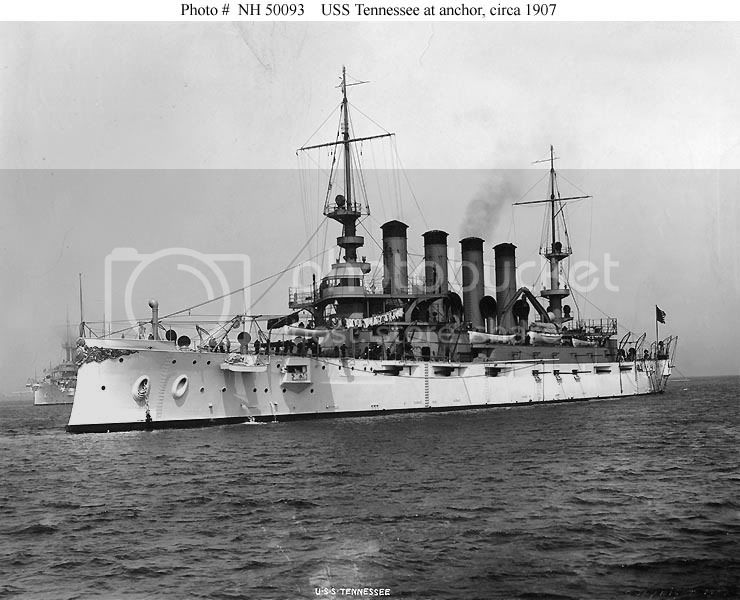
General Statistics
Displacement: 13,712 tons
Length: 504.4 feet
Beam: 72.8 feet
Draft: 25 feet
Speed: 22.16 knots
Complement: 887 officers and men
Armament: 4 x 10 inch guns
16 x 6 inch guns
22 x 3 inch guns
The second USS Tennessee (ACR-10), also referred to "Armored Cruiser No. 10", and later renamed Memphis and renumbered CA-10, was a United States Navy armored cruiser, the lead ship of her class.
The ship was laid down by the Cramp Shipbuilding Company, Philadelphia, Pennsylvania, on the 20th of June 1903, launched on the 3rd of December 1904, sponsored by Miss Annie K. Frazier (daughter of Governor James B. Frazier of Tennessee and later the foundress of the Society of Sponsors of the United States Navy), and commissioned at the Philadelphia Navy Yard on the 17th of July 1906, with Captain Albert O. Berry in command.
This is a fine screen halftone reproduction of a photograph of the ship ready for launching, at the Cramp Shipyard, Philadelphia, Pennsylvania, on the 3rd of December 1904. A portrait of her Sponsor, Miss Annie Keith Frazier, is vignetted into the view.
The original print was provided by Mrs. (Annie) Keith Frazier Somerville, founder of The Society of Sponsors of the United States Navy, for printing as the frontpiece of a calendar produced by the USS Memphis (originally named Tennessee) "Survivors" organization in 1962 for the benefit of needy members.
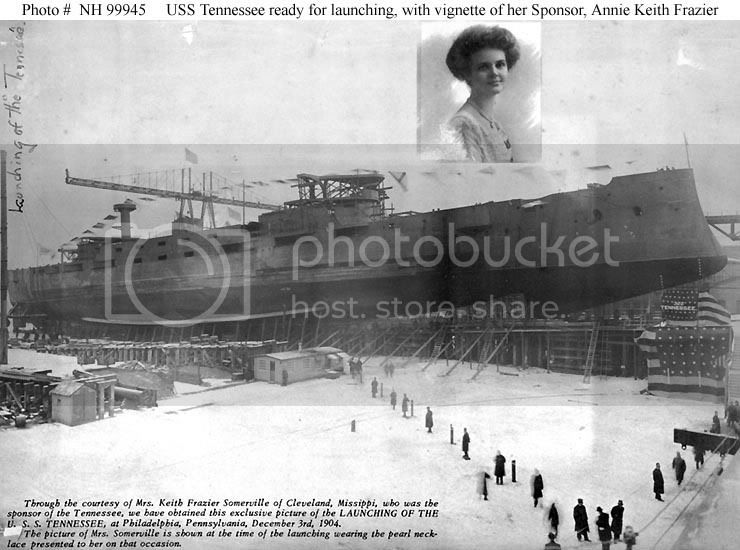
In port, probably while fitting out circa early 1906.Note that her six-inch broadside guns are not installed, though the ship appears to be otherwise complete. This photograph may have been taken at the yard of Tennessee's builder, William Cramp & Sons, Philadelphia, Pennsylvania.
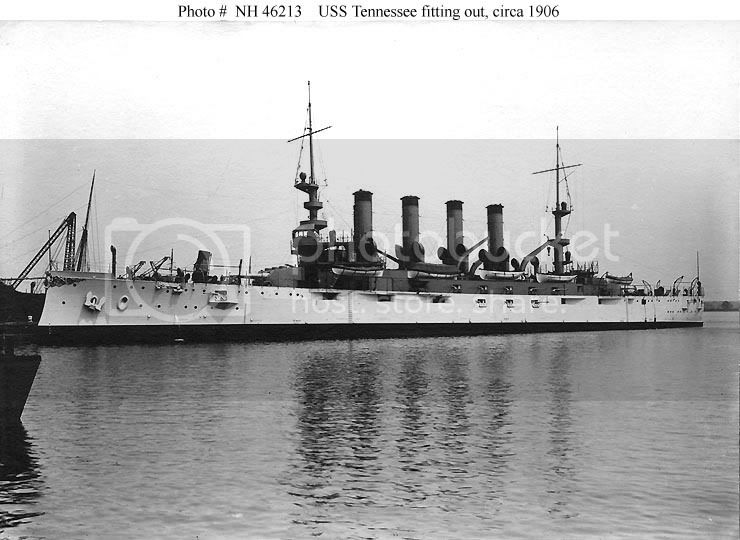
Running trials at 22.16 knots, circa February 1906.
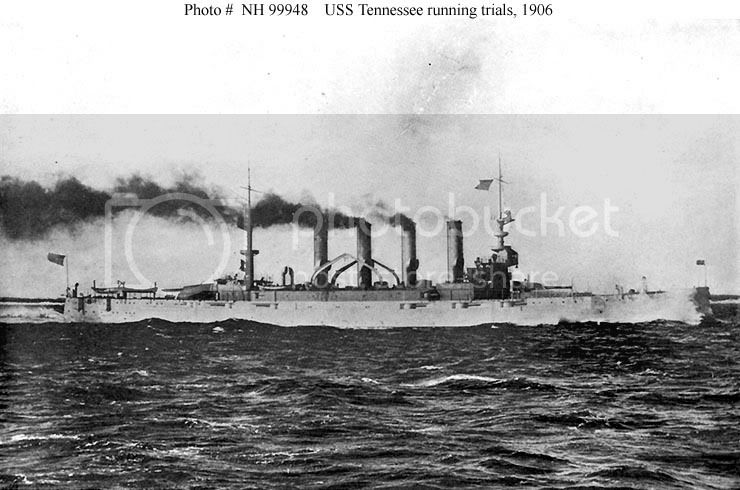
The new armored cruiser departed Hampton Roads on the 8th of November 1906 as escort for the USS Louisiana (Battleship No. 19) in which President Theodore Roosevelt had embarked for a cruise to Panama to check on the progress of work constructing the Panama Canal. After a brief visit to Puerto Rico on the return voyage, the warships arrived back at Hampton Roads on the 26th of November. The Tennessee was present for the Jamestown Exposition held in 1907 to commemorate the tricentennial of the founding of the first English settlement in America.
At anchor in Hampton Roads, Virginia, on 2 May 1907.
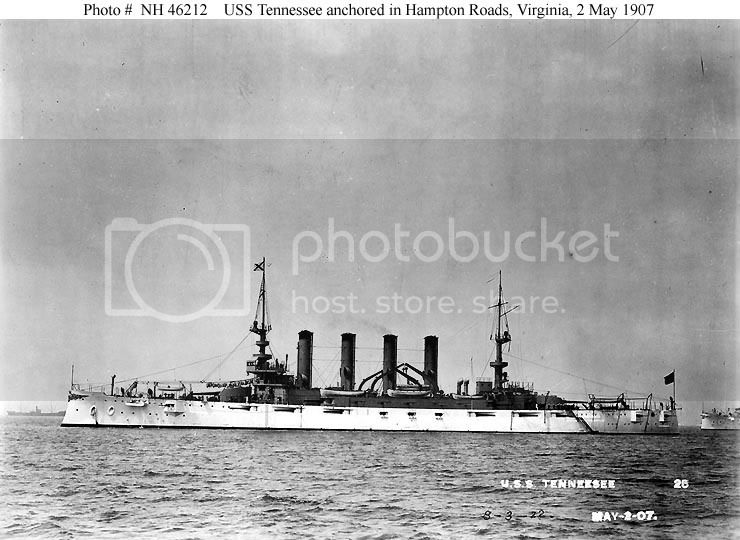
On the 14th of June, the Tennessee sailed for Europe and reached Royan, France, on the 23rd for duty with the Special Service Squadron. She returned home in August but departed Hampton Roads on the12th of October for the Pacific.
In drydock at the Puget Sound Navy Yard, Bremerton, Washington, circa 1907-1908, with men cleaning her underwater hull.
Note the ship's bow decoration.
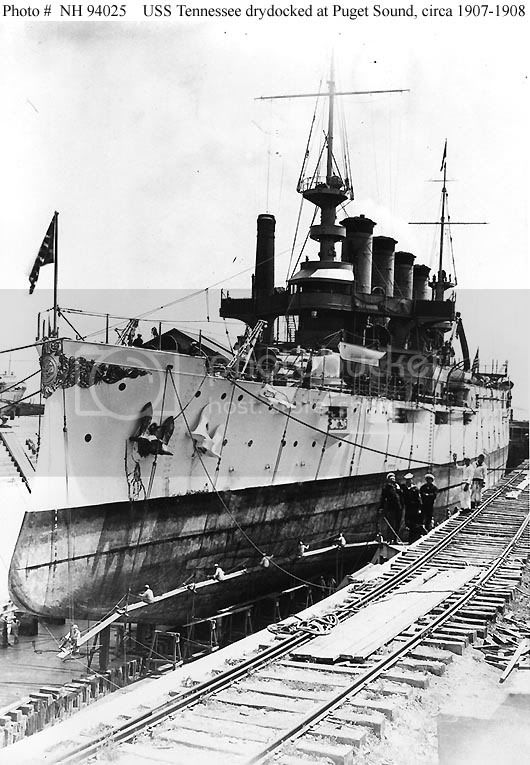
At the Puget Sound Navy Yard, Bremerton, Washington, circa 1909-1910.

The Tennessee then patrolled off the California coast until the 24th of August 1908 when she sailed for Samoa, arriving at Pago Pago on the 23rd of September to resume service with the Pacific Fleet.
At anchor in 1909, soon after the adoption of all-grey paint for U.S. Navy ships.
Note that fancy scrollwork still decorates her bow.
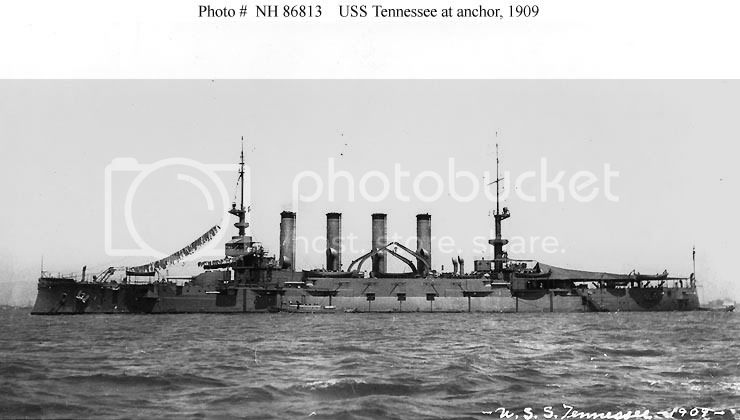
Coaling ship at Honolulu, Hawaii, circa 1909-1910. Three other armored cruisers are visible in the offshore distance.
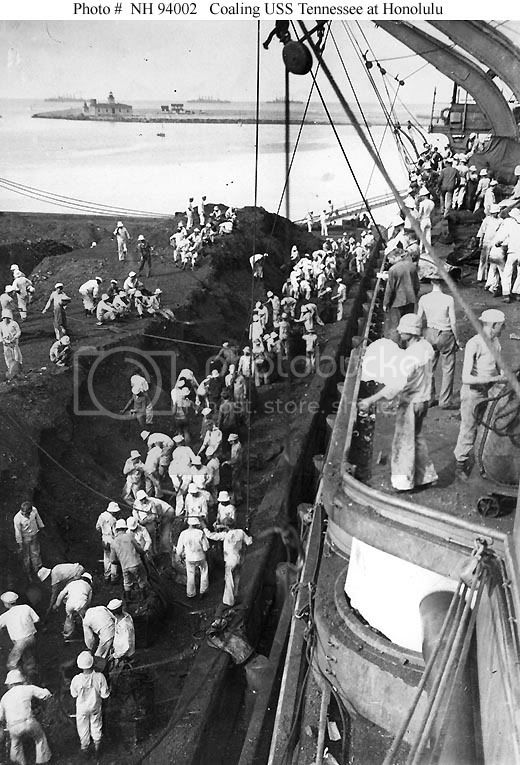
On the 15th of May 1910, she arrived at Bahia Blanca to represent the United States at the centenary celebration of the independence of Argentina. On the 8th of November, the armored cruiser departed Portsmouth, New Hampshire, and proceeded to Charleston, South Carolina, to embark President William Howard Taft for a round trip voyage to Panama to inspect further progress on the Canal. She returned to Hampton Roads on the 22nd of November and then engaged in battle practice off the Virginia coast into February 1911. Following a Mardi Gras visit to New Orleans and a visit to New York early in March, the ship steamed to Cuban waters for two months of operations out of Guantanamo Bay.
Ship's bow decoration on display in Centennial Park, Nashville, Tennessee, where it was erected as a monument. This large decoration was removed from the ship in about 1909.
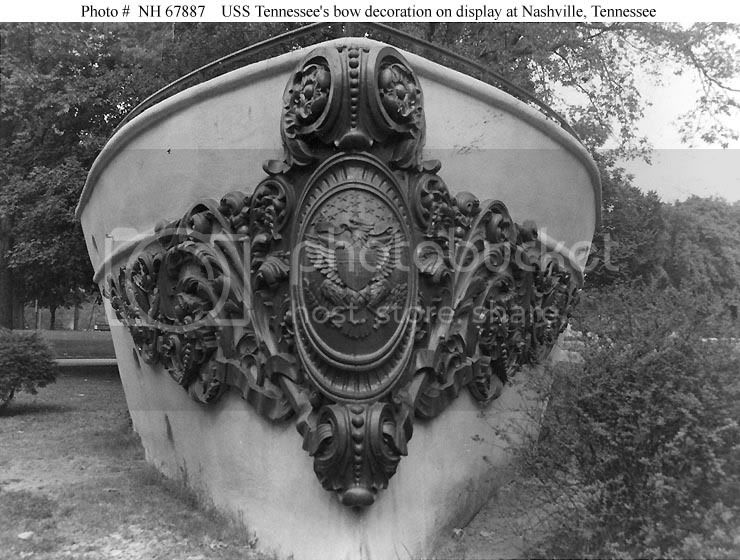
The USS Tennessee was placed in reserve at the Portsmouth Navy Yard on the 15th of June 1911, she remained on the East Coast for a year and one-half before departing Philadelphia on the 12th of November 1912 for the Mediterranean. Arriving off Smyrna (now İzmir), Turkey, on the 1st of December, she remained there protecting American citizens and property during the First Balkan War until the 3rd of May 1913 when she headed home. After reaching Hampton Roads on the 23rd, Tennessee operated on the East Coast until entering the Atlantic Reserve Fleet at Philadelphia on the 23rd of October.
On the 2nd of May 1914, she became receiving ship at the New York Navy Yard.
Seen from astern while in dry dock, circa 1914-1915.
Note the ship's twin three-bladed propellers.
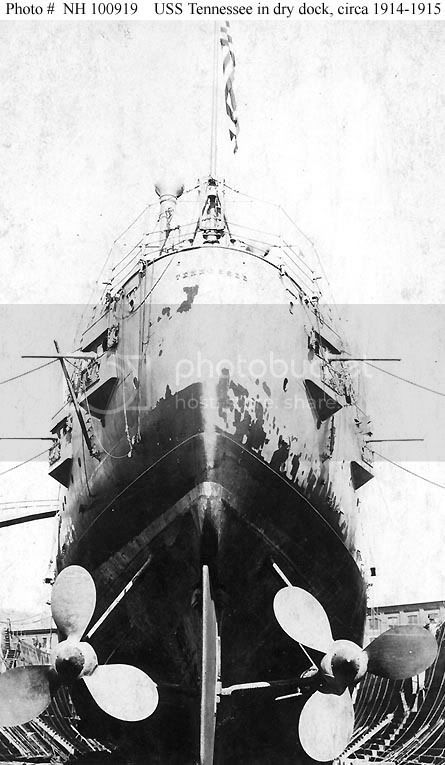
On the 6th of August, Tennessee sailed from New York for duty in Europe through the first half of 1915 supporting the American Relief Expedition. In August, she transported the 1st Regiment, Marine Expeditionary Force, and the Marine Artillery Battalion to Haiti. From the 28th of January to the 24th of February 1916, the cruiser served as flagship of a cruiser squadron off Port-au-Prince, Haiti. In March, she embarked a group of dignitaries at Hampton Roads for a two-month, round trip cruise to Montevideo, Uruguay.
Transiting the Panama Canal, circa 1915-1916, in tow of the tug Mariner.
Note the dredge in the center background.
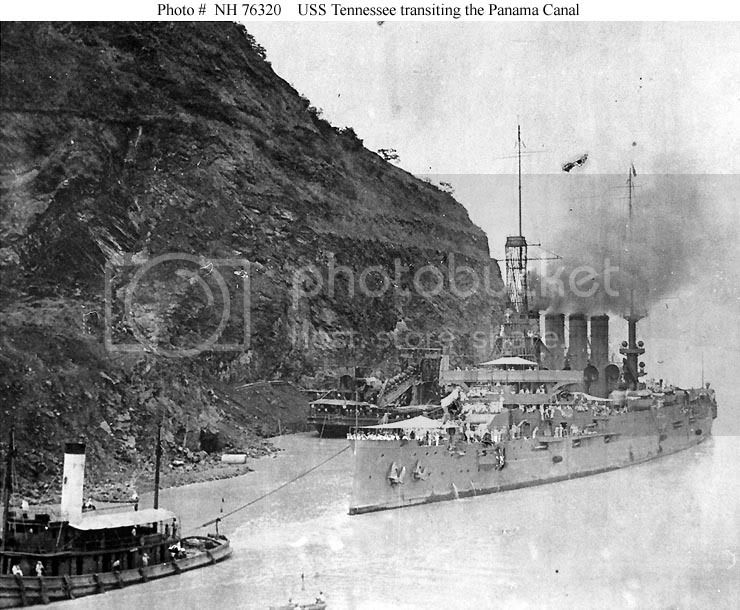
On the 25th of May, Tennessee was renamed Memphis, honouring a city of Tennessee, so that the name "Tennessee" could be reassigned to a new warship, Battleship No. 43. In July, under the command of Edward L. Beach, Sr., the ship got underway for the Caribbean arriving at Santo Domingo on the 23rd July for peace-keeping patrol off the rebellion-torn Dominican Republic. On the afternoon of the 29th of August, while at anchor in the harbor of Santo Domingo, Memphis was driven ashore by an unexpected tsunami and totally wrecked. The casualties, including a boatload of Memphis sailors returning from shore leave, numbered some 40 men dead or missing and 204 badly injured. Due to this incident, Chief Machinist's Mate George William Rud, Lieutenant Claud Ashton Jones and Machinist Charles H. Willey were awarded the U.S. Medal of Honor.
Memphis was struck from the Navy List on the 17th of December 1917 and sold to A. H. Radetsky Iron and Metal Company, Denver, Colorado, on the 17th of January 1922 for scrapping.
Regards
Sean












